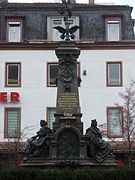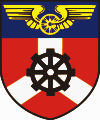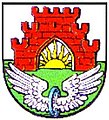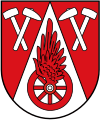Impeller (railway)
The impeller is a symbol of the railway and rail traffic in general and worldwide. It stands for the speed that was outstanding in the early years. Until the aircraft were ready for series production, the speed records were also held by railway vehicles. It is used very rarely in heraldry and is usually represented by a railway wheel (spoked wheel with flange) with a (bird) wing on each side at the height of the hub.
History and use
It probably has its origins in the depictions of the winged messenger of the gods Hermes , who can be found in the Roman equivalent of Hermes in the god Mercurius (whose name refers to trade) and who was the god of traders. The Roman mythology assigns Mercury and Minerva on trade and crafts, as his were they used as symbols and allegories later. Hermes / Merkur is depicted with wings on the helmet and partly on the shoes. As a symbol of speed, he can be seen as a deliverer at the post office in Flensburg .
The impeller as a symbol for the railway is comparatively old.
- As early as 1835 it was used on the reverse (reverse) of the commemorative coin of the Ludwig Railway , a history thaler of the route from Nuremberg to Fürth , minted in Bavaria under Ludwig I. It is a reclining female figure, with an antique robe and hairstyle, holding a stick of Mercury with a laurel wreath slung around it in her right hand and supporting herself with her left arm on a winged wheel. The inscription of the coin in the upper part reads: FIRST RAILWAY IN TEUTSCHLAND WITH STEAM CARS / FROM NUREMBERG TO FÜRTH, in the lower part: BUILT / 1835.
- From 1840 it was used as a symbol on the uniforms of the Munich-Augsburg railway .
- On November 30, 1853, the impeller was introduced in Prussia as a symbol of the railway.
- Even before the transformation into a company under private law, the Deutsche Bundesbahn or Deutsche Bahn in Germany (ultimately at the beginning of 1994) parted with traditional holdings, including the impeller.
In old descriptions of the "winged wheel" and only later of the "wing wheel". The pictorial and plastic representation differs greatly from the later used and is to be assigned to the representation of the side view.
In addition to Germany, the symbol was also used in other countries. That it was a common sign is indicated by its later worldwide use. Significantly, the impeller is very rarely found on the railways in Great Britain, where emblem-like logos are usually used.
For almost 150 years, this symbol was worn by every railroad worker in different versions on their uniforms, hats and related objects. It was the metaphorical term for the railroad. The symbol was expanded through local changes and adjustments: often provided with the crown of a country if it was a monarchy , for example in Prussia , Württemberg or Bavaria . But also smaller states showed their expression and claim here, as in the Grand Duchy of Baden , which provided the impeller used with a crown . The color of the symbol was basically based on the uniform buttons, for example gold in Prussia and silver in Bavaria. It was made in fabric with embroidery, as pure embroidery and in metal for the uniforms. The impeller could be printed or embossed on objects that belonged to the railways or associated companies (exceptions to the use of the logo are, for example, Mitropa and the DRG ). The winged wheel was used in publications (except for timetables) as an easily recognizable symbol of the railway. The symbol was used not only by government institutions but also by other institutions.
Except in the official area, the symbol or the term was used by many leisure and subsidiary organizations of the state railways (for example men's choir Flügelrad or ESV Flügelrad).
How the impeller should "work" has often been humorously discussed or satirized in the literature:
- whether the wings flap and only the wheel turns
- whether the wings remain motionless and the wheel rolls
- whether the wings stay firm and turn with the wheel
- whether the wings flap and turn with the wheel
Nor is it true that impellers with vanes trains on ear webs attached to wing stations hold, are used.
Appearance and variants
There are three views by default:
- the "side view" with a flat wheel and (bird) wings as the oldest version
- plastic or semi-plastic representations of a train wheel with two (plastic) bird wings or one (semi-plastic) bird wing
Monument to the Ludwig Railway in Nuremberg
Logo of the Eisenbahnfreunde Wetterau e. V.
- the "front view" with a stylized representation of the wings and the running surface of the wheel and the wheel rim in the form of two bars

Changes to the classic design were made to represent sectors such as trams or electrical operations, for example by adding jagged lightning bolts.
The Slovak State Railways ( Železnice Slovenskej republiky ) , for example, are stylized .
heraldry
In heraldry, the impeller is a common figure as a coat of arms figure and can be used in two variants in the coat of arms. One variant is the right or left arrangement of the wing (half flight ) on the wheel , and the other is the wing arranged on the same side on both sides of the wheel. The side of the swing arm is to be reported in the coat of arms description . The wings may differ in color from the wheel, but the same tincture is common. Silver, gold, and black are preferred. The view of the wheel can be in the axial direction or in the top view of the wheel tread in the coat of arms, this must also be reported.
Chop is a rail hub in Ukraine
like Bohumín in the Czech Republic
Coat of arms with stylized pair of wings ( Czeremcha PL )
Also: Węgliniec PL coat of arms
Pair of wings in Eydtkuhnen RUS
Pair of wings and wheel (top view of wheel tread) in black ( Dasnice CZ)
Pair of wings and wheel (in axial direction) in silver ( Suchdol nad Odrou CZ)
Pair of wings and wheel (in axial direction) in gold ( Krylbo FI)
... at the back a winged wheel on a silver ear of corn inclined to the left ( Absdorf AT)
Grand piano and wheel in black ( Aulendorf DE)
Pair of wings in gold and wheel (top view of wheel tread) in red ( Falkenberg / Elster DE)
White / silver: pair of wings, inclined wheel ( Ohligs DE)
A grand piano in Oberhausen- Osterfeld
See also
- Railway in heraldry - an overview
Web links
- Impeller (Heraldry) in the Heraldry Wiki
Individual evidence
- ↑ https://www.bibelwissenschaft.de/wibilex/das-bibellexikon/lexikon/sachwort/informationen/details/muenze/ch/a22ec4528c6a072edb37d7e21081f78a/
- ↑ Commemorative coin on the museum.com website: back , front
- ↑ a b Günther Henneking, Wolfgang Koch: The uniform of the German railway worker. Eisenbahn-Kurier, Freiburg (Breisgau) 1980, ISBN 3-88255-825-3 , p. OA
- ↑ www-docs.tu-cottbus.de ( Memento of the original from October 6, 2014 in the Internet Archive ) Info: The archive link was inserted automatically and has not yet been checked. Please check the original and archive link according to the instructions and then remove this notice.
- ↑ a b c Bernhard Schoßig (Ed.): Under the winged wheel. Working and living on the railroad in Munich and in southern Bavaria. Institute for Future- Oriented History, Munich 2001, ISBN 3-8311-2208-3 , p. OA
- ↑ bahninfo-forum.de
- ↑ wwwfotococktail-revival.startbilder.de
- ↑ ESV Flügelrad esv-fluegelrad.de
- ↑ museum.com
- ↑ a b blog.sbb.ch
- ↑ ddr-hautnah.de
- ↑ ddr-hautnah.de
- ↑ Günther Henneking, Wolfgang Koch: The uniform of the German railway worker. Eisenbahn-Kurier, Freiburg (Breisgau) 1980, ISBN 3-88255-825-3 .
- ↑ https://www.oberhausen-osterfeld.de/index.php/osterfeld/wappen.html






















